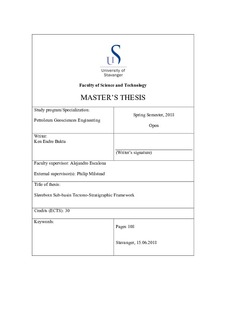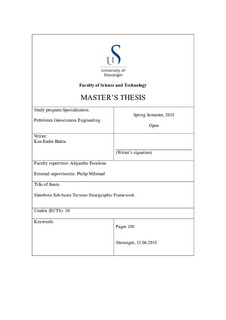| dc.description.abstract | The Slørebotn Sub-basin remains today as an underexplored region on the Norwegian continental shelf, in contrast to the well explored Halten Terrace and northern North Sea that have proven to be prolific hydrocarbon provinces. Therefore, a re-examination of the Slørebotn Sub-basin of the Mesozoic to Cenozoic tectono-stratigraphic evolution has been conducted in order to evaluate the play potential for the Slørebotn area. In this study, seismic reflection, well and core data have been used to define the tectono-stratigraphic framework that comprises nine sequences, ranging from: 1) Carnian-Rhaetian, consisting of arid alluvial rocks; 2) Hettangian-Toarcian, consisting of arid alluvial rocks; 3) Aalenian-Callovian, consisting of alluvial to marginal marine rocks; 4) Oxfordian-Early Ryazanian, consisting of deep marine anoxic shale that is interbedded by marine sandstones; 5) Ryazanian-Albian, consisting of open marine shales with poorly sorted slope aprons in its basal part; 6) Cenomanian, consisting of open marine shales; 7) Turonian, consisting of open marine shales and several coarse submarine fans; 8) Late Turonian-Early Maastrichtian, consisting of open marine shales, but coarse submarine fans and turbidites characterize its basal and upper part, respectively; and 9) Lower Paleocene-Early Pleistocene, consisting of slope and basinfloor turbidites at the base and deep marine Eocene turbidites. The latter was established by seismic interpretation and is to date, an untested play in the mid-Norwegian Sea. By analogy to the North Sea, the Eocene turbidite play has proven to be successful with substantial amounts of hydrocarbons discovered to date. The main difference between the Slørebotn Sub-basin and the adjacent northern North Sea and the Halten Terrace can be observed in the Early Jurassic stratigraphic record. Although all the three reference areas experienced tectonic movement during the late Early Jurassic, the study area was clearly exposed to a greater magnitude of uplift that resulted in erosion of the entire Lower Jurassic and in some places older sedimentary rocks as well. The reason is interpreted to be related to the development of the Møre Basin in accordance to an upper-plate margin in an extensional regime and that underplating by igneous rocks is causing the excessive uplift of the Slørebotn Sub-basin. | nb_NO |

